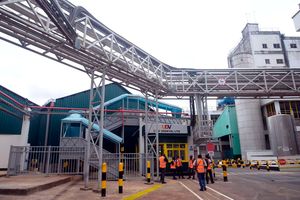Premium
Yes, we have plenty of food this season

Agriculture Cabinet Secretary, Peter Munya. The CS says several measures have been put in place by the government to ensure the country is food secure even as the Covid-19 crisis rocks the country. PHOTO | FILE | NATION MEDIA GROUP
What you need to know:
- All counties in the lower and upper eastern are harvesting too. Harvesting of pulses (beans, cowpeas and green grams) commenced in all counties from early June, while harvesting of pigeon peas will start from end of the month.
- Supply of fresh vegetables is also high. This is backed by research. Some 78 per cent of households reported having enough food stocks in a survey carried out by the Kenya National Bureau of Statistics in June.
- The maize balance sheet projects that at the end of September, there will be a surplus of 15.7 million 90kg bags and 7.5 million bags of beans.
- The projected production for maize and beans is 36.9 million bags and 4.9 million bags, respectively.
Several measures put in place by the government, as well as favourable weather, could see the country avoid a food crisis as it fights the Covid-19 pandemic, Agriculture Cabinet Secretary PETER MUNYA spoke to Pauline Kairu
Does the country have enough food?
Yes, harvesting of most long rains cereal crops (maize, sorghum, rice and millet) commenced from mid-July in many parts of the country.
They include the Coast, lower parts of Nyanza and western, central Rift (Baringo, Bomet, Narok, Kajiado and parts of Nakuru) and central.
All counties in the lower and upper eastern are harvesting too. Harvesting of pulses (beans, cowpeas and green grams) commenced in all counties from early June, while harvesting of pigeon peas will start from end of the month.
Generally, we have had high amounts of rainfall in several parts of the country. Although floods affected some crops such as beans and irrigated rice, the rains also led to increased fodder, raising milk production by 11 per cent especially in the arid and semi-arid counties.
Supply of fresh vegetables is also high. This is backed by research. Some 78 per cent of households reported having enough food stocks in a survey carried out by the Kenya National Bureau of Statistics in June.
Food prices and domestic supply have also remained steady for all the staples. There is adequate food in all markets and in most areas, prices of maize are below or close to the five-year average and remain fairly stable.
In June, private millers were supported by the government to import four million bags of maize at a reduced tax of 10 per cent.
The maize balance sheet projects that at the end of September, there will be a surplus of 15.7 million 90kg bags and 7.5 million bags of beans.
Does this mean food production hasn’t been affected by the Covid-19 crisis?
No. During the partial lockdown, the ministry, in collaboration with county governments, ensured that agricultural production was not affected.
The ministry also worked with the national Covid-19 emergency committee and the Ministry of Health to develop guidelines that facilitated movement of essential service providers.
This included suppliers of farm inputs, importers and exporters of essential goods, as well as non-closure of agricultural markets.
Moreover, farmers who mostly operate far from their farms were provided with movement permits.
The projected production for maize and beans is 36.9 million bags and 4.9 million bags, respectively.
We don’t expect to experience any crisis since projected production will be normal and it is expected that the normal monthly imports of maize, beans, rice and wheat will supplement the domestic stock.
But we are not sitting pretty. We have put in place a number of measures to ensure hunger doesn’t kill anyone.
For instance, the ministry established a toll-free call centre to enable the public, especially farmers, to reach us directly and get immediate support to continue their operations.
We have also created a 'food security war room' comprising various experts that monitor different aspects of food security such as agricultural productivity, food prices, imports and exports as well as supplies of inputs.
We are also all set to launch a digitisation strategy that will hasten the adoption of various digital platforms to support farming, including e-subsidy, e-extension and digital food balance sheet.
he ministry will also channel certified seeds or seedlings and other farm inputs to the vulnerable small-scale food producers to ensure continued food supply.
Insurance is also picking up. For example, 25,200 farmers who took crop insurance in 2019 were compensated some Sh100 million. This has helped farmers build resilience against the effects of climate change.
Going forward, should we expect more efforts to boost food production?
Yes, we will provide vulnerable households with early maturing seeds, especially in 13 counties that were affected by flooding.
These are Kisumu, Tana River, Busia, Mandera, Isiolo, Wajir, Garissa, Kilifi, Migori, Siaya, Turkana, Kakamega and Taita-Taveta. At Sh4 million per county, this will cost Sh52 million.
We shall also conduct training and data collection at a cost Sh10 million and enhance operations at the call centre.
We also expect to supply kitchen garden kits across the country, which will cost us Sh1 billion, while the supply of fruit tree seedlings (two million of them at Sh300 each) will cost us 600 million.





